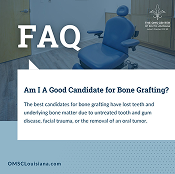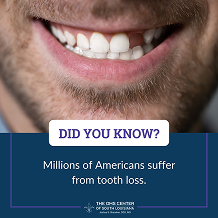










We Strive for The Best Patient Care
At The OMS Center of South Louisiana, everything we do is custom-tailored to the patient’s needs. We’re dedicated to providing a seamless, comfortable, and supportive experience from start to finish. When you join us for a consultation, oral surgeon, Dr. Brandner, will spend as much time as needed getting to know you, listening to your concerns, and explaining different treatment options.

Personal & Compassionate Care
At The OMS Center of South Louisiana, our goal is to help patients understand the treatment options available to them, empowering them to make fully informed decisions about their oral healthcare. The best way to find out about different treatment options is to schedule a consultation with us.


Small Steps Make a Big Difference
Our wisdom tooth removal procedure is designed for faster healing with reduced discomfort. We use minimally invasive techniques that ensure small incisions, preserve soft tissue, and keep swelling to a minimum. With tailored IV sedation and a focus on post-op comfort, patients can resume their normal routine quickly—typically within 24 hours—and without the need for opioid pain medications or modified diets.









Joshua S. Brandner, DDS, MD, is a trusted oral and maxillofacial surgeon proudly serving patients throughout Southern Louisiana.
Dr. Brandner completed both his MD and DDS certifications at the Louisiana State University Health Sciences Center and finished an Oral and Maxillofacial Surgery residency at the University of Washington in Seattle. Dr. Brandner is known for his compassionate approach to patient care and his skills in patient education.
“We want your entire experience to be as great as your surgical result. We take care of people the way they should be taken care of.”
— Dr. Joshua Brandner, The OMS Center of South Louisiana
For a Healthy, Beautiful Life
At The OMS Center of South Louisiana, we believe in offering a personalized and thoughtful approach to each patient’s care.
We are committed to excellence, safety, and innovation in every aspect of our work. Our team goes beyond just medical expertise — we listen, understand, and support you at every step of your journey, delivering superior results and a compassionate, patient-centered experience.
Tailored Solutions for Every Patient
The All-on-4® technique is a popular form of dental implant that allows patients to restore their smile with four strategically placed implants throughout the mouth. This is an excellent option for patients with extensive tooth loss.

Dental implants provide a long-lasting way to replace lost or missing teeth. Titanium posts are placed into the jaw to serve as artificial roots. From there, we place replacement teeth that look and feel natural.

The majority of people need to have their wisdom teeth removed to avoid long-term dental complications. Our practice can provide wisdom teeth removal safely, comfortably, and expediently for young and older patients.

When a patient’s teeth are too sick or too damaged to be viable, the best approach is to extract and replace them. We offer safe and expedient tooth extraction services, along with tooth replacement options, for patients of various ages.

We see many patients with persistent jaw pain, whether due to a physical deformity, traumatic accident, or condition such as TMJ. Sometimes, surgical intervention can alleviate pain and restore the jaw’s full aesthetics.

Tooth loss is often accompanied by the loss of bone tissue, which can make restoration more challenging. Through bone grafting, Dr. Brandner can regrow bone tissue and better prepare the patient for dental implants.

One of our top priorities is to provide patients with a comfortable, positive treatment experience. As such, we offer a number of sedation and anesthesia options to ensure that your treatment does not involve any pain or discomfort. Learn more about our approach to sedation dentistry.

These advanced treatments can enhance your natural beauty, providing you with a more youthful, refreshed appearance without the need for surgery.
“Truly Exceptional”

We want your visit to be smooth and convenient. Take a moment to prepare for your appointment by filling out the necessary paperwork.

At The OMS Center of South Louisiana, patient education is one of our most cherished values. We take pride in creating a space where our patients are well-informed on their diagnosis, the different treatment options, and the expected outcomes. If you have any questions about an oral surgery procedure and what to expect, we would love to help you find the answer. Visit our Frequently Asked Questions page to view some of the most common inquiries.

It is a pleasure to collaborate with local doctors, dentists, and orthodontists. If you have a patient who needs oral surgery, we can help.







Stay connected with us for updates, tips, and patient success stories. Follow us on Instagram and Facebook to see the latest from The OMS Center of South Louisiana!